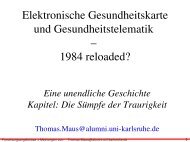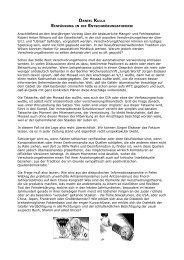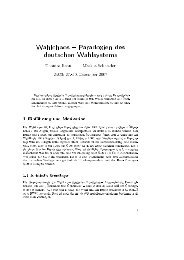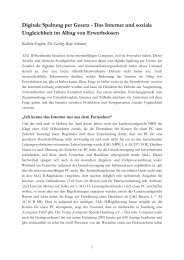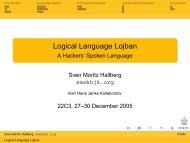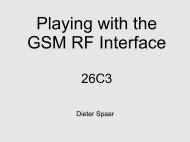Complete Hard Disk Encryption Using FreeBSD's GEOM Framework
Complete Hard Disk Encryption Using FreeBSD's GEOM Framework
Complete Hard Disk Encryption Using FreeBSD's GEOM Framework
Create successful ePaper yourself
Turn your PDF publications into a flip-book with our unique Google optimized e-Paper software.
in most cases not encrypted by default either. Since all encryption and decryption of the<br />
data on the hard disk is done transparently to the user once the passphrase has been<br />
provided, it is easy to forget that some directories might contain data which is stored on<br />
a different machine and made available through NFS, for example – in which case the<br />
data is transferred in the clear over the network, unless explicitly set up otherwise.<br />
The mounting facility in UNIX is very powerful; but it also makes it difficult to keep<br />
track of which medium actually holds what data.<br />
The network poses of course an additional threat, because of an attacker's ability to<br />
target the machine remotely. The problem has already been discussed in chapter 1. If a<br />
particular machine is easier to attack remotely than locally, any reasonable attacker will<br />
not even bother with getting physical access to the machine. In that case it would make<br />
no sense to use complete hard disk encryption, because it does not eliminate the<br />
weakest link (the network connectivity).<br />
If, on the other hand, not the network, but the unencrypted or not fully encrypted<br />
hard disk is the weakest link and the attacker is also capable of getting physical access to<br />
the machine (for reasons discussed in chapter 2.4), then complete hard disk encryption<br />
makes sense.<br />
A key point to remember is that as long as a particular storage area is attached, the<br />
data residing on it is not protected any more than any other data accessible to the<br />
system. This applies to both GBDE and GELI; even unmounting an encrypted storage<br />
area will not protect the data from compromise since the corresponding device node<br />
providing access to the plain text still exists. In order to remove this plain text device<br />
node, the storage area in question must be detached. With GBDE this must be done<br />
manually, GELI has a feature that allows for automatic detachment on the last close –<br />
but this option must be explicitly specified.<br />
Since the partition holding the operating system must always be attached and<br />
mounted, its contents are also vulnerable during the entire time the system is up. This<br />
means that remotely or even locally introduced viruses, worms and trojans can<br />
compromise the system in the same way they can do it on a system without complete<br />
hard disk encryption.<br />
Another way to attack the system would be by compromising the hardware itself, for<br />
example by installing a hardware keylogger. This kind of attack is very hard to defend<br />
against and this paper makes no attempt to solve this issue.<br />
What complete hard disk encryption does protect against, is attacks which aim at<br />
either accessing data by reading out the contents of the hard disk on a different system<br />
in order to defeat the defenses on the original system or by compromising the system<br />
stored on the hard disk, so the encryption key or the data itself can be leaked. <strong>Encryption</strong><br />
does not, however, prevent the data from being destroyed, both accidentally and<br />
intentionally.<br />
If it is chosen that the encrypted partition is mounted directly as the root filesystem –<br />
without the need for a memory disk, then it is crucial that a strong passphrase be<br />
chosen, because that will be the only thing required to access the encrypted data.<br />
Choosing the memory disk approach makes for a more resilient security model, since it<br />
enables the user to use a lockfile (GBDE) or a keyfile (GELI) – in order to get access to the<br />
data.<br />
While all these previously mentioned conditions and precautions matter, it is<br />
absolutely crucial to understand that the concept of complete hard disk encryption<br />
depends upon the assumption that the data on the removable medium is trusted.<br />
The removable medium must be used because the majority of the hardware is not<br />
capable of booting encrypted code. Since the kernel and all the other code necessary for<br />
mounting the encrypted partition(s) must be stored in the clear on the removable<br />
21



